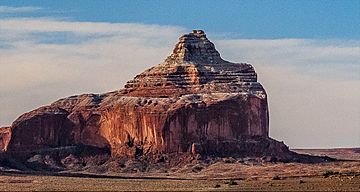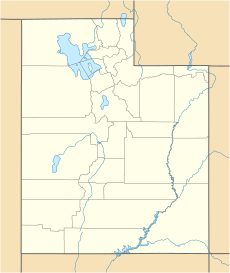Boundary Butte (Rainbow Plateau) facts for kids
Quick facts for kids Boundary Butte |
|
|---|---|

Northwest aspect
|
|
| Highest point | |
| Elevation | 4,934 ft (1,504 m) |
| Prominence | 897 ft (273 m) |
| Isolation | 2.58 mi (4.15 km) |
| Parent peak | Tower Butte |
| Geography | |
| Location | Navajo Reservation San Juan County, Utah, U.S. |
| Parent range | Colorado Plateau |
| Topo map | USGS Gunsight Butte |
| Geology | |
| Age of rock | Jurassic |
| Type of rock | Entrada Sandstone |
| Climbing | |
| Easiest route | class 5.x climbing |
Boundary Butte is a cool sandstone summit in Utah, near the Arizona border. It stands tall at 4,934 feet (about 1,504 meters) and is located south of Lake Powell. This amazing landmark is part of the Navajo Nation land. It's about 11.5 miles northeast of Page, and it rises an impressive 1,200 feet above Lake Powell. Its name, Boundary Butte, comes from its location right on the Utah-Arizona border!
What is Boundary Butte Made Of?
Boundary Butte is a type of mountain called a butte. It's mostly made of a rock called Entrada Sandstone. This is the same kind of rock you'll find in nearby mountains like Dominguez Butte (about 2.5 miles north) and Tower Butte (about 2.6 miles southwest).
Underneath the Entrada Sandstone, you'd find other rock layers. These include the Carmel Formation and, even lower, Page Sandstone, which is visible near the lake. On top of the Entrada layers, there's Romana Sandstone, covered by the Morrison Formation.
This butte is located on the southern edge of the Great Basin Desert, which is part of the larger Colorado Plateau. Any rain or snow that falls on Boundary Butte eventually flows into the Colorado River.
Cool Views of Boundary Butte
Weather Around Boundary Butte
Boundary Butte is in a very dry place, also known as an arid climate zone. This means it has hot, super dry summers. Winters are chilly, but there's usually very little snow.
The best times to visit are during spring and fall. The weather is usually just right for exploring!
| Climate data for Page, Arizona | |||||||||||||
|---|---|---|---|---|---|---|---|---|---|---|---|---|---|
| Month | Jan | Feb | Mar | Apr | May | Jun | Jul | Aug | Sep | Oct | Nov | Dec | Year |
| Record high °F (°C) | 64 (18) |
72 (22) |
82 (28) |
91 (33) |
102 (39) |
107 (42) |
109 (43) |
106 (41) |
100 (38) |
93 (34) |
77 (25) |
66 (19) |
109 (43) |
| Mean daily maximum °F (°C) | 43.1 (6.2) |
50.3 (10.2) |
59.5 (15.3) |
68.5 (20.3) |
78.5 (25.8) |
90.2 (32.3) |
95.1 (35.1) |
92.0 (33.3) |
83.5 (28.6) |
69.7 (20.9) |
53.8 (12.1) |
43.7 (6.5) |
69.0 (20.6) |
| Mean daily minimum °F (°C) | 26.3 (−3.2) |
30.4 (−0.9) |
37.0 (2.8) |
43.6 (6.4) |
52.6 (11.4) |
62.3 (16.8) |
68.3 (20.2) |
66.4 (19.1) |
58.4 (14.7) |
46.6 (8.1) |
34.7 (1.5) |
27.1 (−2.7) |
46.1 (7.8) |
| Record low °F (°C) | −11 (−24) |
6 (−14) |
18 (−8) |
25 (−4) |
31 (−1) |
44 (7) |
56 (13) |
46 (8) |
40 (4) |
24 (−4) |
16 (−9) |
1 (−17) |
−11 (−24) |
| Average precipitation inches (mm) | 0.61 (15) |
0.48 (12) |
0.65 (17) |
0.50 (13) |
0.40 (10) |
0.14 (3.6) |
0.58 (15) |
0.69 (18) |
0.66 (17) |
0.99 (25) |
0.56 (14) |
0.48 (12) |
6.74 (171.6) |
| Average snowfall inches (cm) | 2.1 (5.3) |
1.2 (3.0) |
0.2 (0.51) |
0 (0) |
0 (0) |
0 (0) |
0 (0) |
0 (0) |
0 (0) |
0 (0) |
0.5 (1.3) |
1.4 (3.6) |
5.4 (13.71) |
| Average precipitation days (≥ 0.01 in) | 4.5 | 4.0 | 5.2 | 3.5 | 3.2 | 1.7 | 4.6 | 5.2 | 4.5 | 4.3 | 3.2 | 3.9 | 47.8 |
| Average snowy days (≥ 0.1 in) | 0.9 | 0.6 | 0.3 | 0 | 0 | 0 | 0 | 0 | 0 | 0 | 0.2 | 0.6 | 2.6 |
| Source: NOAA | |||||||||||||








